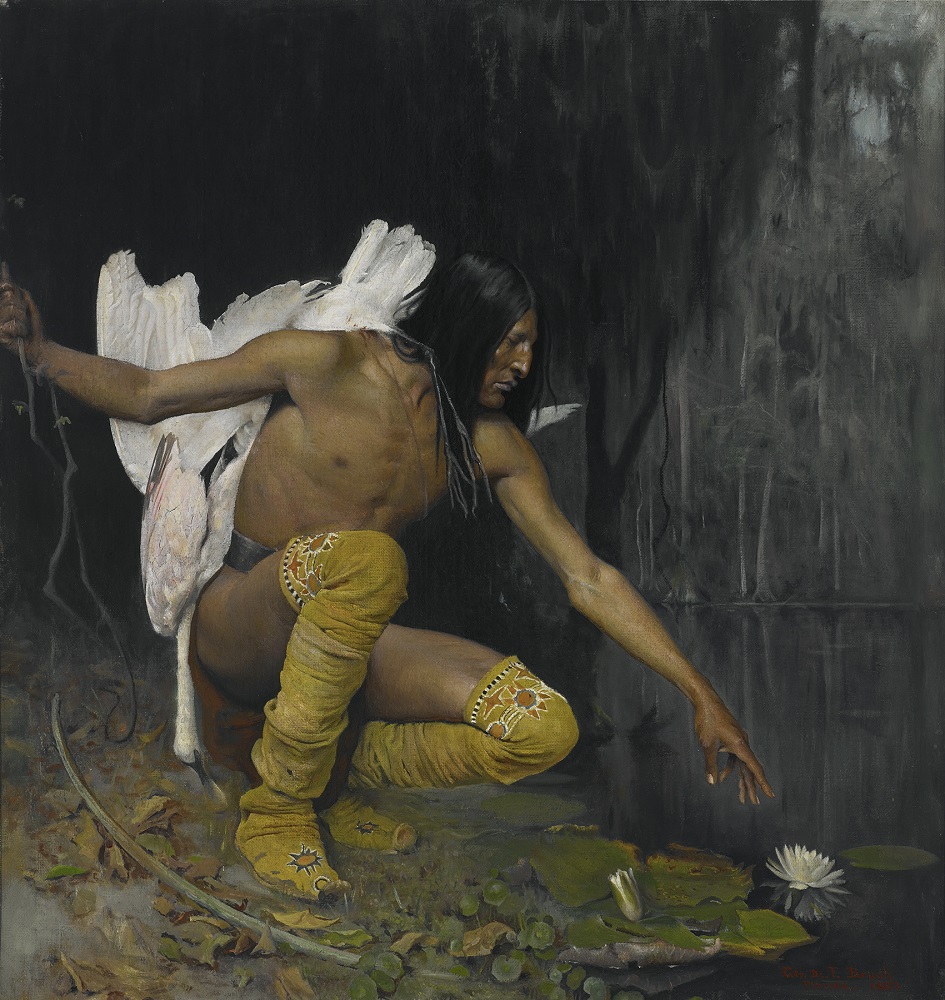
The Indian and the Lily, 1887
George de Forest Brush (1855 – 1941)
Oil on canvas
Crystal Bridges Museum of American Art, Bentonville, Arkansas

George de Forest Brush
Within the focus exhibition Changing Perspectives of Native Americans, located in Crystal Bridges’ Colonial and Early Nineteenth-Century Art Gallery, hangs one of Crystal Bridges most popular paintings, The Indian and the Lily, by George de Forest Brush, whose birthday we celebrate on September 28.
The subject of this painting is a Native American man with the body of a spoonbill crane carried over his shoulder, marking him as a hunter. He pauses from his hunt and stretches out his arm toward a water lily, floating serenely just out of reach. Viewers often linger in observance of this work’s tranquil beauty, as if in silent vigil to our intrinsic connection to the natural world. The artist has placed the viewer in a precarious position, teetering on the verge of disruption of this intimate scene, just as the subject teeters on the edge of the water.
Though many critics praised the artist for what they perceived as a realistic chronicling of Native American life, in fact the dress and accoutrements of the Native hunter in the painting are a mish-mash of items from several different tribes, some of whose ancestral lands were hundreds of miles from any landscape such as that portrayed in the painting. Brush never saw himself as journalistic. “I live for art, and not for Indians,” Brush declared, although he produced a number of works depicting Native Americans between 1882 and 1898.
“I do not paint from the historian’s or antiquarian’s point of view,” Brush declared. “I am interested in those habits and deeds in which we have feelings in common. Therefore, I hesitate to add any interest to my pictures by supplying historical facts. If I were required to resort to this in order to bring out the poetry, I would drop the subject at once.” Yet, although Brush appropriated the perceived Native American lifestyle primarily as a metaphor for American concerns and topics, his work did in fact draw attention to the plight of the Native peoples who were rapidly disappearing from their ancestral lands.

Miggles, 1880
George de Forest Brush, 1855-1941
Oil on canvas
Chrysler Museum of Art
Gift of Walter P. Chrysler, Jr.
From the time he returned to the States from his studies in Paris in 1880, George de Forest Brush drew attention with his uniquely American subject matter. His first exhibited painting, titled Miggles, illustrated a short story by American writer Bret Harte about a saloon entertainer named Miggles who had given up her livelihood to take care of her lover. The two were protected by a grizzly bear named Joaquin. Miggles shows a young woman reclining against a massive bear. A combination of American storytelling and European allusions to classical figures, this painting is the first in a long history of works by Brush that engage in a dialogue between American and European traditions and explore the place of art in American culture. Miggles features a distinctly American subject matter, while the posture and garments of the reclining woman are indisputably classical.

Mourning Her Brave, 1883
George de Forest Brush
Oil on panel
Gilcrease Museum, Tulsa, Oklahoma Gift of the Thomas Gilcrease Foundation, 1955
Shortly after his exhibition of Miggles, George de Forest Brush set out to explore the American West with his brother Alfred Brush. During this journey, Brush completed portraits of Shoshone, Arapahoe, and Crow men. As he refined his studies, Brush rejected the title of “historian” or “anthropologist,” no matter how much critics praised what they called his “authentic” portrayals of Indian life. Indeed, Brush’s portraits show little of the hardships inflicted on Native Americans by forced relocations, prejudice, and poverty. Instead, Brush reiterated that he only desired to portray universal themes, such as the suffering of grief in his painting Mourning her Brave. This work was part of a series completed between 1882 and 1886, in which Brush explored the universality of conflict and death.
Brush continued to move even further from the reality of American Indian life. In 1886, he principally painted a series that explored aesthetic appreciation. Centered on a lone Indian, these paintings showed men striving for artistic perfection in the meditative atmosphere of nature. The Indian and the Lily, painted in 1887, captures this theme.
While similar in representation to the classical story of Narcissus, reminding the audience of the perils of seeking an unattainable perfection, The Indian and the Lily also referenced the popular novella Imensee, written by German poet Theodor Storm. In this story, a young man reaches out for a perfect water lily but nearly drowns when he falls into the pond and becomes tangled in the deep-reaching roots of the flower. When he escapes, he looks back to see the water lily floating calmly, as if unaware or unperturbed by his struggles in the depths below. In this context, the scene of Bush’s painting could be a metaphor for the struggle of the American Indian tribes to remain unified with nature and maintain their way of life, unaware of, as the viewer alone knows, the futility of this reach. This interpretation would make The Indian and the Lily one of Brush’s most political works.
George de Forest Brush revealed what he considered to be the most essential elements of American culture and spirit, and dedicated himself to the cause of celebrating the balance between man, art, and nature. Viewing the peaceful harmony within The Indian and the Lily, one cannot help but believe it is a balance worth pursuing.
Interested in learning more about the Indian paintings of George De Forest Brush? Check out the book George de Forest Brush: The Indian Paintings by Nancy K. Anderson in the Crystal Bridges Library.



